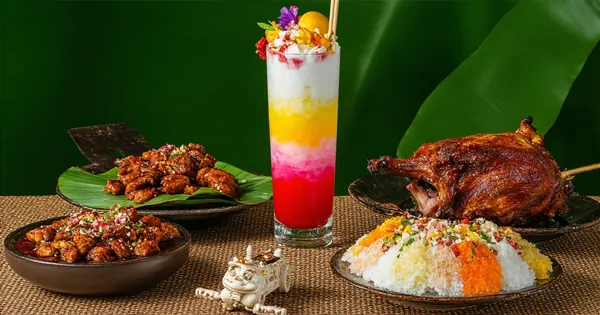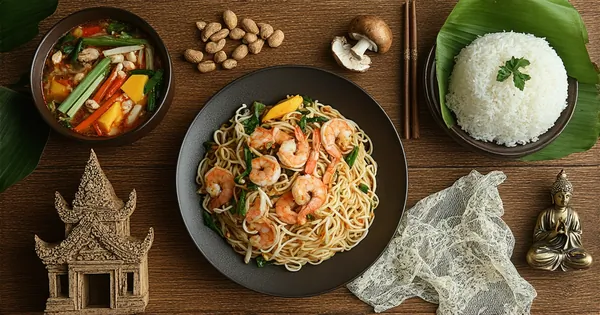
Philippines
Explore the Philippines' vibrant food scene with our expert guide. Discover authentic Filipino cuisine from street vendors to regional specialties, empowering your culinary journey.
Southeast Asian cuisine is a sensory explosion, a vibrant tapestry woven from fragrant herbs, fiery chilies, and the historical threads of ancient trade routes. It's a region where the sizzle of a street-side wok is the daily soundtrack and every meal is a masterclass in balancing sweet, sour, salty, and spicy. To explore the food here is to dive into a world of intense flavor, communal joy, and deep-rooted cultural traditions.
The culinary identity of Southeast Asia is a mosaic of distinct zones, each with a unique philosophy. The Indochina peninsula, including Vietnam and Cambodia, emphasizes fresh herbs, light broths, and subtle flavors, showing a clear legacy of French colonial influence in its techniques and ingredients. In contrast, Maritime Southeast Asia, encompassing Malaysia and Indonesia, is defined by a richer, heavier use of dried spices, coconut milk, and grilling traditions shaped by Indian, Middle Eastern, and Malay history. Thailand stands as a unique culinary crossroads, mastering the art of balancing all flavor profiles into a singular, harmonious experience. Despite these differences, a unifying philosophy of communal dining, the absolute centrality of rice, and the vibrancy of street food culture connects the entire region into a cohesive, yet diverse, culinary world.
Unlike many cuisines that rely on dried spice blends, the heart of countless Southeast Asian dishes is a freshly pounded paste ("kroeung" in Cambodia, "rempah" in Malaysia). This aromatic base of lemongrass, galangal, chilies, and other fresh ingredients is the foundation of the region's vibrant, layered flavors and represents a core culinary technique that defines its fresh character.
Street food in Southeast Asia isn't a novelty; it's the backbone of daily life for millions. Vendors often specialize in a single dish perfected over generations, offering a level of quality and authenticity that can surpass restaurants with extensive menus. It's a culture of trust, convenience, and unparalleled culinary specialization, making it the most genuine way to eat.
Meals are almost always served "family style," with multiple dishes placed in the center of the table. Each person receives a plate of plain rice, which serves as a neutral canvas for the intense flavors of the shared dishes. You take small portions from the communal plates to eat with your rice throughout the meal. Rice is the main event, not a side dish.
A key philosophy is empowering the diner to perfect their own meal. Most noodle soup stalls and eateries provide a condiment caddy, often called "kruang prung" in Thailand, with sugar, fish sauce, chili flakes, and chili-infused vinegar. This allows each person to adjust the sweet, salty, spicy, and sour elements to their exact preference, making every bowl a personalized creation.
A traveler's guide to managing heat and enjoying the flavors without the pain.
How to use the correct utensils in different parts of the region to eat like a local.
While both are delicious, their core flavor bases differ significantly. Thai curries, like Green Curry, are built on a fresh, aromatic paste of herbs like lemongrass, galangal, and kaffir lime, and are often thinner and soupier. Malaysian curries, like Rendang, are typically richer and thicker, built on a base of dry-roasted spices like cumin, coriander, and turmeric, reflecting a stronger Indian influence.
Street food is the great social and economic equalizer. It provides affordable, high-quality meals for everyone from students to office workers. It's also a hub of social life and a testament to specialization, where vendors perfect one single dish over decades. This focus creates a level of expertise and flavor that is hard to replicate in a larger restaurant setting.
Fish sauce, or "nam pla" in Thai and "nuoc mam" in Vietnamese, is the fundamental source of salt and savory depth (umami) in much of the region's cooking. It's used in the same way salt might be in Western cuisine but adds a far greater complexity of flavor. The quality varies greatly, with premium versions being less pungent and having a more nuanced, savory taste.
Look for restaurants with the word "Jay" or a yellow flag with red lettering, which signifies strict Buddhist vegetarian food in Thailand and surrounding areas. In Malaysia and Singapore, seek out Indian or Chinese vegetarian eateries. When ordering, be explicit and say "no fish sauce, no oyster sauce," as these are often not considered meat by default.
The two are fundamentally different noodle soups. Pho is a Vietnamese dish with a clear, aromatic broth, simmered for hours with spices like star anise and cinnamon, served with rice noodles and fresh herbs. Laksa, popular in Malaysia and Singapore, is a rich, spicy, and creamy soup with a coconut milk and chili paste base, often containing tofu puffs and seafood.
Explore the Philippines' vibrant food scene with our expert guide. Discover authentic Filipino cuisine from street vendors to regional specialties, empowering your culinary journey.
Navigate Thailand's vibrant food scene with our expert guide. Learn smart eating tips, discover authentic street food, and understand the rich culture behind Thai cuisine.
At Tasteplorers, our mission is to provide the most accurate and useful travel information in the world. To achieve this, all content on this site is created through our unique editorial framework. We utilize leading AI research tools, guided by our proprietary prompts, and a multi-stage validation process. This entire system is overseen by our editorial team to ensure everything we publish meets our high standards for accuracy, cultural nuance, and practical value for travelers.
Learn more about our Editorial Process and our Mission.
Discover Europe's diverse culinary landscape, from Mediterranean flavors to hearty Alpine fare. Learn to navigate markets, decode menus, and eat like a local.
Discover the vibrant cuisines of Latin America & the Caribbean. Our expert guide covers everything from Mexican street food to Peruvian ceviche and market tips.
Explore Oceania's diverse food scene. Learn about Polynesian earth ovens, Fijian feasts, and the vibrant café culture of Australia and New Zealand.
